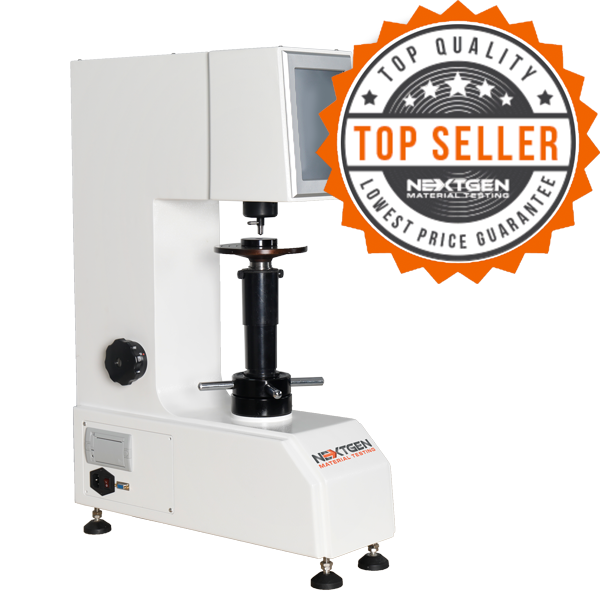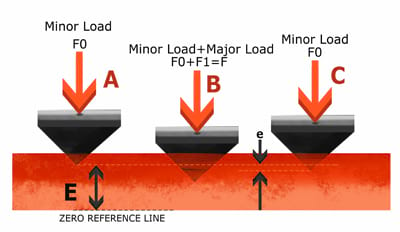It is an established notion in the field of manufacturing that a certain object is just as good as the materials it is made of. As such, production specialists need to make sure that every component, material, and material treatment used to build a certain device or machine is going to be strong and durable.
This is where the Rockwell Hardness test comes into play since it was specifically designed to measure the durability of a material. The system is designed for testing in accordance to ASTM E18 standard. But before you decide to invest on a Rockwell Hardness Tester, there are a few things about the test that you need to understand first.
What is the Rockwell Hardness Test?
The Rockwell Hardness Test is actually one of several tests aimed to gauge a material’s compatibility as a component to an object based on their strength and durability. The other tests in the series include the the Knoop, Brinell, and Vickers methods.
The concept of the Rockwell Hardness test is essentially similar to its counterparts. A sample material is fed on to either a digital or manual Rockwell hardness tester which would then drop a set load ending with an indenter on the surface. Then, the strength of the material will be determined by the nature of the indentation left on the sample.
However, the Rockwell method differs greatly from the Knoop, Vickers, and Brinell methods in one aspect. Where the others measure strength by the size or width of the indentation left, the Rockwell method measures strength through depth. The rationale behind the Rockwell method is that the durability of a material is better gauged on its ability to maintain structural integrity from damages that are not merely superficial. This is why the method is commonly used in the fields of metallurgy and engineering, where the integrity of a material cannot be simply observed at a surface level.
How is the Test Conducted?
As was stated, the Rockwell hardness test is essentially similar to other methods in the sense that strength is gauged through applying load on to a material. How the Rockwell test goes about doing this, however, is different.
First, a minor load is applied to the surface which determines the zero position. Once the zero position is established, a heavier major load is then applied to the material which causes the indentation.
At the same time, the minor load is maintained all throughout the test. Some variations of the test would require that the major load remain on the material until it the indent it has made is deep enough.
Once the major load is removed, the depth of the penetration starting from the zero position is then measured. As with all hardness tests, the strength of the material is inversely proportional to the damage it sustained. As such, under the Rockwell method, materials tend to rate higher at the hardness scale if the indentation left on them is closer to the surface.
Why is the Rockwell Method Reliable?
In some cases, gauging the strength of materials through Rockwell Hardness Tester is preferable. This is due to a number of advantages as listed below.
1. No Material Preparation is Required
In some tests, the sample material has to be buffed, ground, cut up, and polished in order to get the most accurate of readings. Essentially, tests like the Knoop and Vickers method need for the sample surface to be as flat as possible with little to no variation.
In the Rockwell method, since the depth of the indentation is being measured, there is no need for the sample to undergo different processes to make the test accurate. This is also why the Rockwell method is used when testing unrefined materials like ore.
2. No Optical Evaluation
With the Rockwell method, the value of the hardness is directly readable since most hardness testers using this method don’t use diagonal scales to measure hardness. This is quite true if you opt for a digital Rockwell Hardness tester as the values are immediately displayed on screen after a few seconds of processing.
With the absence of optical evaluation, the chances of the operator making an error on the readings are greatly reduced.
3. Cost-Effective
Since Rockwell hardness testers do not need to be equipped with elaborate optical evaluation systems, they have rather short test cycles. This would allow for a more efficient testing process where operators can quickly move through one specimen to another.
Add to this the fact that Rockwell testers are considerably inexpensive compared to other instruments, the Rockwell method makes for a rather cost-effective process. And this is not the only way the Rockwell method helps its operators save up on costs.
4. Non-Destructive Nature
Despite the fact that the test leaves a sizeable indent on the material, the Rockwell method is a non-destructive and non-invasive process. After every test, the specimen itself can still be used for other purposes.
This means that the Rockwell method can effectively help its operators reduce their waste. If your workshop also processes raw materials, this could help in reducing operational costs.
How Accurate is the Rockwell Hardness Tester System?
The RockGen Rockwell Hardness Testing System was designed to test the hardness level of metal based on the indentation they leave on a tested material according to the Rockwell scale. The machine is capable of measuring the resolution of a material to a 0.001″. NextGen’s Rockwell hardness testers are guaranteed to provide one of the absolute highest accuracies on the market. The Rockwell Hardness Testing measurement is calculated by first applying the preliminary force test called a preload for a specified period of time called a dwell time.
After the specified period of time, an additional load, also known as the major load, will be applied. Now the total force has been applied and the measurements of the depth of the indentation are taken from the reference point to the final depth of the penetrator after it has undergone its major load. The distances between the two imprints are known as the Rockwell Hardness Values.
How Many Tests Are There for the Rockwell Regular Test Scales?
The Rockwell Hardness Tester has many different scales depending on the application of the tester on different materials. There is a total of 30 Rockwell hardness scales available to use for hardness testing and hardness value. The Rockwell Regular Scales Testing use a preload of 10kgf and a major load of 50kgf, 100kgf, or 150kgf. The Superficial Rockwell scales are for materials that are thin as 0.15mm or 0.0006 inches and that use a preload of 3kgf and a major load of either 15kgf, 30kgf, or 45kgf.
What Are the Limitations of the Rockwell Testing Systems?
The Rockwell Testing systems depend on the material that is being tested including the hardness, thickness, indentation positioning, and scale limitations on the materials that are being tested. The material being tested must be at least 10x thicker than the indentation that the Rockwell indentation is going to be when it is made of the material.
NextGen’s Rockwell Hardness Testers are amongst the leading Rockwell Manufacturing machines and can provide you with all of the options your company needs including the Rockwell Twin Digital Testing machines. The Twin model is among the most popular products we have allowing the operator to test both Rockwell regular and Rockwell superficial scales on a single instrument. Enjoy the benefits of Rockwell hardness testing and the unprecedented accuracy it provides.
In Conclusion
Despite its advantages, the Rockwell method is not exactly applicable at all instances. However, it does not mean that a Rockwell Hardness Tester will not yield considerably accurate measurements which should help any workshop.
This is why it is important that you should find a rather reputable manufacturer who can then provide you with a well-build Rockwell tester. If calibrated right, these instruments can help you improve the quality of your facility’s output while reducing waste.
To learn more, contact us today.


